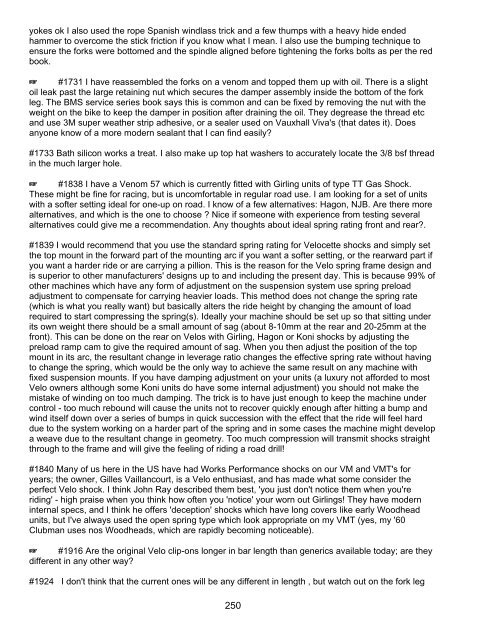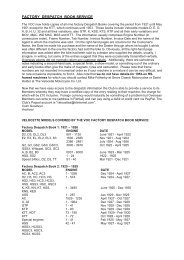The Knowledge - Velocette Owners Club
The Knowledge - Velocette Owners Club
The Knowledge - Velocette Owners Club
You also want an ePaper? Increase the reach of your titles
YUMPU automatically turns print PDFs into web optimized ePapers that Google loves.
yokes ok I also used the rope Spanish windlass trick and a few thumps with a heavy hide ended<br />
hammer to overcome the stick friction if you know what I mean. I also use the bumping technique to<br />
ensure the forks were bottomed and the spindle aligned before tightening the forks bolts as per the red<br />
book.<br />
L #1731 I have reassembled the forks on a venom and topped them up with oil. <strong>The</strong>re is a slight<br />
oil leak past the large retaining nut which secures the damper assembly inside the bottom of the fork<br />
leg. <strong>The</strong> BMS service series book says this is common and can be fixed by removing the nut with the<br />
weight on the bike to keep the damper in position after draining the oil. <strong>The</strong>y degrease the thread etc<br />
and use 3M super weather strip adhesive, or a sealer used on Vauxhall Viva's (that dates it). Does<br />
anyone know of a more modern sealant that I can find easily?<br />
#1733 Bath silicon works a treat. I also make up top hat washers to accurately locate the 3/8 bsf thread<br />
in the much larger hole.<br />
L #1838 I have a Venom 57 which is currently fitted with Girling units of type TT Gas Shock.<br />
<strong>The</strong>se might be fine for racing, but is uncomfortable in regular road use. I am looking for a set of units<br />
with a softer setting ideal for one-up on road. I know of a few alternatives: Hagon, NJB. Are there more<br />
alternatives, and which is the one to choose ? Nice if someone with experience from testing several<br />
alternatives could give me a recommendation. Any thoughts about ideal spring rating front and rear?.<br />
#1839 I would recommend that you use the standard spring rating for <strong>Velocette</strong> shocks and simply set<br />
the top mount in the forward part of the mounting arc if you want a softer setting, or the rearward part if<br />
you want a harder ride or are carrying a pillion. This is the reason for the Velo spring frame design and<br />
is superior to other manufacturers' designs up to and including the present day. This is because 99% of<br />
other machines which have any form of adjustment on the suspension system use spring preload<br />
adjustment to compensate for carrying heavier loads. This method does not change the spring rate<br />
(which is what you really want) but basically alters the ride height by changing the amount of load<br />
required to start compressing the spring(s). Ideally your machine should be set up so that sitting under<br />
its own weight there should be a small amount of sag (about 8-10mm at the rear and 20-25mm at the<br />
front). This can be done on the rear on Velos with Girling, Hagon or Koni shocks by adjusting the<br />
preload ramp cam to give the required amount of sag. When you then adjust the position of the top<br />
mount in its arc, the resultant change in leverage ratio changes the effective spring rate without having<br />
to change the spring, which would be the only way to achieve the same result on any machine with<br />
fixed suspension mounts. If you have damping adjustment on your units (a luxury not afforded to most<br />
Velo owners although some Koni units do have some internal adjustment) you should not make the<br />
mistake of winding on too much damping. <strong>The</strong> trick is to have just enough to keep the machine under<br />
control - too much rebound will cause the units not to recover quickly enough after hitting a bump and<br />
wind itself down over a series of bumps in quick succession with the effect that the ride will feel hard<br />
due to the system working on a harder part of the spring and in some cases the machine might develop<br />
a weave due to the resultant change in geometry. Too much compression will transmit shocks straight<br />
through to the frame and will give the feeling of riding a road drill!<br />
#1840 Many of us here in the US have had Works Performance shocks on our VM and VMT's for<br />
years; the owner, Gilles Vaillancourt, is a Velo enthusiast, and has made what some consider the<br />
perfect Velo shock. I think John Ray described them best, 'you just don't notice them when you're<br />
riding' - high praise when you think how often you 'notice' your worn out Girlings! <strong>The</strong>y have modern<br />
internal specs, and I think he offers 'deception' shocks which have long covers like early Woodhead<br />
units, but I've always used the open spring type which look appropriate on my VMT (yes, my '60<br />
<strong>Club</strong>man uses nos Woodheads, which are rapidly becoming noticeable).<br />
L #1916 Are the original Velo clip-ons longer in bar length than generics available today; are they<br />
different in any other way?<br />
#1924 I don't think that the current ones will be any different in length , but watch out on the fork leg<br />
250





